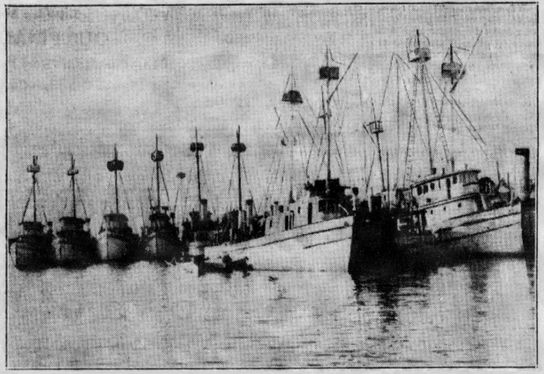
Fisheries in Beaufort
First known as “Fishtown,” Beaufort long served as an important center for commercial fishing and seafood production (11). The town grew in reputation for its plentiful inshore fisheries, shellfish, whaling, and, most notably, abundant schools of menhaden. Menhaden is often referred to as the fish that built Beaufort (9). This fishery started in New England and, following the Civil War, it expanded to southern waters. At its height, the fishery supported upwards of ninety factories and hundreds of fleets ranging from Maine to Florida (9). Beaufort and other port towns in North Carolina served important roles in sustaining this national fishery. In the early 1980s, North Carolina landings made up about 70% of the South Atlantic fishery, and at its peak, there were twelve processing factories, four of which were operating in Beaufort (9). These factories captured and converted this fish into oil, fertilizer, and fishmeal.
As commercial fishing was the cornerstone of the town’s economy, downtown Beaufort and the surrounding community were built to support this industry and its workers. The waterfront and downtown streets were filled with docks, fish houses, and storage spaces for commercial nets and gear, all of which enabled Beaufort to thrive in a productivist-economy (8). Not only did the town serve as an important port for landing menhaden, fisheries also developed for shrimp, oysters, scallops, and flounder (12). And so, thousands of pounds of North Carolina seafood were brought to shore, processed, and distributed across the United States (9). The importance of marine resource extraction in the productivist era both created and reflected a community and regional identity tied deeply to the ocean and fishing.
Despite the historical success of the menhaden fishery, stocks dramatically declined in the late 1980s (13). The resulting fisheries regulations consolidated menhaden operations, reducing the ability of fishers and processing plants based out of Beaufort to participate in this fishery (14). As other industries brought greater economic stability to the town, commercial fishing was pushed to the fringes. Eventually, Beaufort’s last menhaden processing plant closed in 2005 (15). Menhaden was not the only fishery that succumbed to the impacts of the diminishing productivity and profitability of commercial fisheries. Scallops, flounder, and river herring all declined in abundance, and North Carolina shrimp faced competition from global markets that had lower operation costs. Increases in regulations and local environmental concerns made it difficult for fishers to switch to new species of fish (16). The compounding effects of these changes contributed to the decline of commercial fishing as the primary profession and fixture of the town’s economy.

Some Key Events
For a more complete timeline of fisheries in Beaufort, click here.






